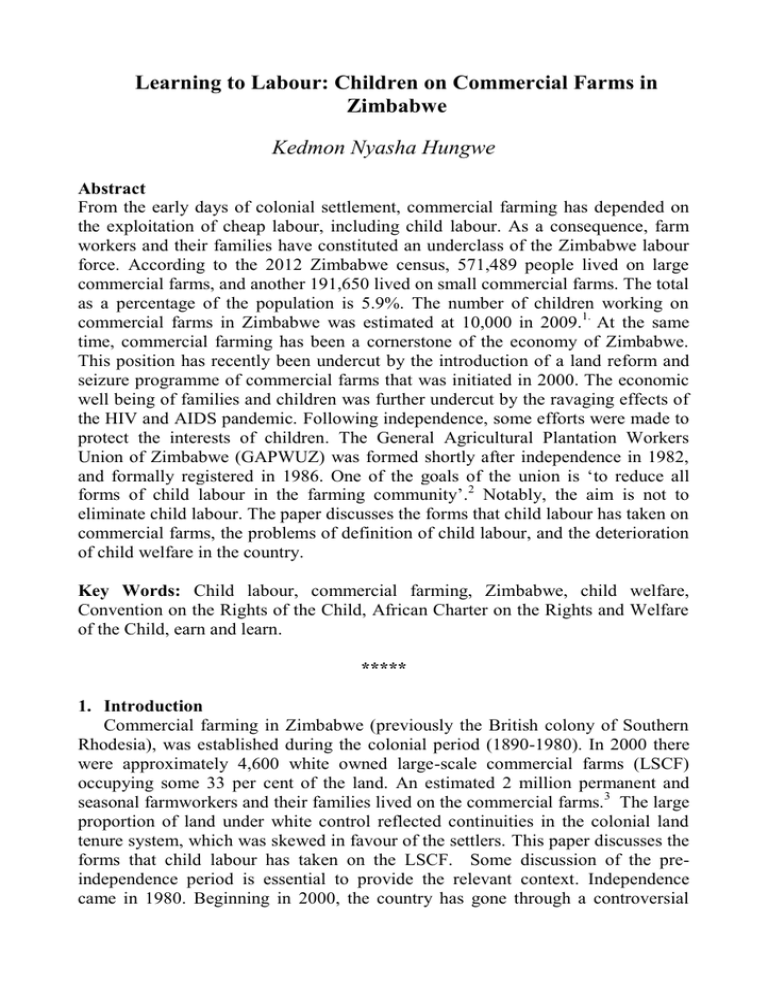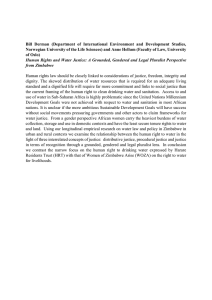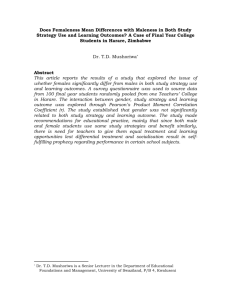Learning to Labour: Children on Commercial Farms in Zimbabwe Kedmon Nyasha Hungwe
advertisement

Learning to Labour: Children on Commercial Farms in Zimbabwe Kedmon Nyasha Hungwe Abstract From the early days of colonial settlement, commercial farming has depended on the exploitation of cheap labour, including child labour. As a consequence, farm workers and their families have constituted an underclass of the Zimbabwe labour force. According to the 2012 Zimbabwe census, 571,489 people lived on large commercial farms, and another 191,650 lived on small commercial farms. The total as a percentage of the population is 5.9%. The number of children working on commercial farms in Zimbabwe was estimated at 10,000 in 2009.1. At the same time, commercial farming has been a cornerstone of the economy of Zimbabwe. This position has recently been undercut by the introduction of a land reform and seizure programme of commercial farms that was initiated in 2000. The economic well being of families and children was further undercut by the ravaging effects of the HIV and AIDS pandemic. Following independence, some efforts were made to protect the interests of children. The General Agricultural Plantation Workers Union of Zimbabwe (GAPWUZ) was formed shortly after independence in 1982, and formally registered in 1986. One of the goals of the union is ‘to reduce all forms of child labour in the farming community’.2 Notably, the aim is not to eliminate child labour. The paper discusses the forms that child labour has taken on commercial farms, the problems of definition of child labour, and the deterioration of child welfare in the country. Key Words: Child labour, commercial farming, Zimbabwe, child welfare, Convention on the Rights of the Child, African Charter on the Rights and Welfare of the Child, earn and learn. ***** 1. Introduction Commercial farming in Zimbabwe (previously the British colony of Southern Rhodesia), was established during the colonial period (1890-1980). In 2000 there were approximately 4,600 white owned large-scale commercial farms (LSCF) occupying some 33 per cent of the land. An estimated 2 million permanent and seasonal farmworkers and their families lived on the commercial farms. 3 The large proportion of land under white control reflected continuities in the colonial land tenure system, which was skewed in favour of the settlers. This paper discusses the forms that child labour has taken on the LSCF. Some discussion of the preindependence period is essential to provide the relevant context. Independence came in 1980. Beginning in 2000, the country has gone through a controversial Learning to Labour 2 __________________________________________________________________ land reform process that has radically changed land ownership patterns. There are now less than 300 white farmers out of the original total of 4,500. The implications of this are discussed. 2. Foundations Cheap African labour was the foundation of commercial farming from the beginning of the colonial period. This continued to be so after independence. A survey carried out in 1997 showed that each farm employed between 21 and 50 workers, in addition to the use of seasonal and child labour. 4 One of the ways by which labour was procured during the colonial period was through a tenancy system. Land-dispossessed African families (otherwise called tenants) were granted permission stay on the farms in exchange for labour. The South African Native Commission report of 1904-05 provides critical insights into the practice. William Napier, who appeared before the commission testified that he ‘required’ tenants to work ‘from 2 to 5 months per year, the average being about 3 months’. Children were expected to work as well. He provided rudimentary educational instruction for the children, but only reluctantly. 5 ‘Personally I prefer the uneducated one. I find him more amenable’, he testified.6 The Native Development Act of 1929 and the Non-Government Schools Regulations of 1959 were intended to provide for the establishment and supervision of farm schools. Nevertheless school facilities remained rudimentary. The Education Commission of 1962 established that the majority of farm schools provided no more than 5 years of schooling, and the facilities were sub-standard.7 Farm schools were of two types: state-aided, and unaided. Aided schools were required to meet minimum standards. Nevertheless, the commission was scathing in its assessment of these schools, characterizing them as sub-standard.8 As for the unaided schools, the 1962 Education Commission determined that they were of no educational value. Farmers mostly used them to attract and retain working families.9 The poor educational provision blocked upward socio-economic mobility for generations of workers and their children. A cycle of dependence was therefore created, forcing succeeding generations of farm children to stay on the farms.10 The distribution of farm schools by type for 1969 is indicated in table 1. Kedmon Nyasha Hungwe 3 __________________________________________________________________ Table 1: Farm school enrolments by grade, 1969.11 Unaided Grade 1 2 3 4 5 6 7 Numbers 6887 4616 3595 2054 1055 1674 675 % 33.5 24.5 17.5 9.9 5.1 8.2 3.3 Aided Numbers 2756 1899 1377 1024 777 146 51 Total % 31.8 24.6 17.8 13.2 10.1 1.9 0.6 Numbers 9343 6515 4972 3078 1832 1819 726 Girls (% of total) % 33.0 23.0 17.6 10.9 6.5 6.3 2.6 46.1 45.6 43.1 41.7 35.3 28.8 9.5 Testimonies to the 1969 Parliamentary Select Committee on Education provide further insights about the situation, just over a decade before independence. 12 Farming representatives testified against the need for anything more than a basic education on the farms. Employers testified that a rudimentary education was sufficient for African workers. ‘Up to standard 4 was useful and adequate’ for the more technical work. 13 In sum, the attitude of commercial farmers favoured a lowly educated, and compliant workforce. Children were considered an integral part of the workforce. The marginal costs of employing children were relatively low because they required no additional investment in housing and other amenities. They could also be employed at lower rates of pay than adults. Table 2 indicates the statistics of juvenile employment for 1961 and 1969.14 Juveniles were defined as workers less than 16 years of age. The figures understate the numbers because they exclude females. Table 2: Male Juvenile employment in Rhodesia, 1961 and 196915 Rhodesian Juveniles Foreign Total Juveniles % of total employment % Adult male employment 1961 14,814 9,842 24,660 10,4 12,4 1969 18,497 9,491 27,988 10.8 14,4 % Change 24.9 -3.6 13,5 3. The years 1980-2000 In 2000, the number of children living on commercial farms was estimated at between 400,000 and 460,000.16 Studies indicated that most school age children worked did farm work during school holidays and weekends.17 In contrast to the early days of colonial occupation, child participation in the labour force was more a consequence of poverty and necessity than employer compulsion. Poverty levels remained very high on the farms. In interviews, children mostly accepted work as a way of generating much needed income. According to the research conducted by Learning to Labour 4 __________________________________________________________________ Sally Musandirire, the main reason children’s work was to supplement family income.18 The following comments from children reinforce the point: 19 I am paid Z$600,20 like other workers on the farm, and besides looking after myself, I also use the money to buy groceries for my widowed mother in the rural areas (16 year old girl). I must look after my three brothers, since our parents died, so I work for the foreman, looking after his children and get Z$200 for food. Some of us work during the holidays for money for school fees and uniforms. We are paid 30 cents per kg of cotton picked. According to the 2000 Save the Children study, 21 the recruitment and supervision of children’s work was primarily a responsibility for the farm foremen, rather than the farm owners. Children took it as a favour when they were hired to work. Children’s work encompassed the following activities: child minding for farm employees and farmers; weeding and planting; and picking cotton, and fruit. Some children also did work that involved the use of machinery. In 2004, a total of 12,351 work related injuries were recorded.22 A total of 9,683 (78.4%) were associated with agricultural work. Some 12.5% did not indicate occupation and could still include a substantial proportion of agriculturally related child workers. After independence, lack of access to education has continued to be a critical factor in sustaining farm worker dependency. Nationally, school enrolments increased dramatically after 1980. However, there were no significant increases in the commercial farming sectors as the government continued to leave the responsibility to farmers. 23 In 2000, approximately 14.8 per cent of all commercial farms were reported to have a primary school, either registered, or not registered. 24 Under Zimbabwe law, farm schools can be registered if 1) the enrolment is at least 280 for grades 1 through 7; 2) the buildings meet government specifications; 3) there are adequate sanitary facilities; and 4) there is adequate accommodation for teachers. The advantage of registering schools include: teachers’ salaries paid by the government; a per capita book and materials grant to the schools based on attendance; and supervision of teachers and enforcement of curriculum standards. The majority of farmers have opted not to register schools in order to have more control over resource allocation, curriculum standards, and hiring of teachers. A critical indicator of access to education is distance walked to get to school. According to the Save the Children study, 25 the mean distance from commercial farms to a registered primary school was 7.3 kilometres. It was 5.3 kilometres to an unregistered school. The mean distance to a government secondary school was 14 kilometres. The total walking distance per day was up to 26.6 kilometres, a situation exacerbated by the fact that children were not properly fed, and often Kedmon Nyasha Hungwe 5 __________________________________________________________________ walked on empty stomachs. 26 Farms where the distance from school was greatest also had the highest proportion of children working on the farms and who were not in school. A sample of comments collected through the Save the Children include the following: 27 We walk more than ten kilometres to school. We arrive late at 10:00 am when others have learned a lot. We leave before school finishes so as not to get home by dark. Sometimes we reach home by 7.00 pm. We cannot do any homework, because we will be tired, so it’s no use going to school One boy fainted at school because of hunger; most of us go to school on empty stomachs or just drink maheu (nutritious drink) before we leave home Children living on the farms valued good careers beyond farm life. In interviews, some wanted to be doctors, engineers, lawyers, auto mechanics, police officers, teachers, clerks, or authors. At the same time, they were cognizant of the limiting realities of their lives. One child put it this way: 28 We would like to get to university and college, but schools are far away from here and most of us end up at grade 6, some at grade seven. There are many children who have completed grade seven but they are sitting at home…Where can they go with only grade seven? According to the 2004 Child Labour Report produced by Zimbabwe Central Statistical Office (CSO), the most commonly cited reason for children leaving school was financial (68.4%).29 The data were not disaggregated to indicate the proportion on commercial farms, but it is reasonable to infer a higher rate. The vulnerability of children has been exacerbated by the HIV-AIDS epidemic. This has caused an increase in the numbers of orphans and child-headed households. Farm schools have typically limited educational provision to the primary level. The discussion now turns to a modified scheme developed on tea plantations that has provided for secondary education. It has been called the Earn and Learn Scheme (ELS). 4. Earn and Learn Scheme: Opportunity and Controversy The Tanganda tea plantations in Zimbabwe have operated a version of child economic labour model called Earn and Learn Scheme (ELS). 30 The program was initiated during the colonial period to supplement the labour force on the Learning to Labour 6 __________________________________________________________________ plantations. It operated for over 60 years until it came to and end in 2013. The company cited negative press reports and concerns about the effects of the negative reports on its international image.31 At the time the program was ended, it operated on four schools with a combined enrolment of over 1,000 pupils. The ELS scheme required children to contract to work for tea estates as a condition of attendance. Critics charged that the company was contravening the country’s child labour laws. The schools were run as residential boarding schools. This would give the tea estates maximum control over the students’ time and labour. In the later years, children under 13 were exempted from working, but this was not always enforced. The primary work involved tea-picking tea on plantations. Payment depended on the amount of tea plucked, and the rate was the same as for adult workers. During the colder season (May through August) the children worked 4½ hours a day during weekdays, as well as Saturday mornings. For the rest of the year, they worked from dawn to mid-day, with school following in the afternoons. During the first quarter of the year, students worked eight hours a day, six days a week, on top of their schoolwork. In total, students were working in the fields up to 40 hours a week. The tea leaves were placed in baskets that the children carried on their backs. Baskets weighed up to 15 kilogrammes when full. 32 Bourdillon found that the work was hard for the students. They struggled to focus and stay awake during classes, after a hard day in the fields. Students who did not meet work targets were sometimes barred from attending class. ‘The regime is certainly harsh,’ Bourdillon concluded. The drop out rate was about 15 per cent. Despite this, he believed the system had some merit because it made schooling possible for students who might not otherwise have access. 33 5. Prospects: Fast Track Land reform and beyond As noted at the beginning of this paper, land distribution in Zimbabwe was historically skewed in favour of white farmers. In July 2000, President Mugabe officially launched what has been termed the ‘fast track land reform’ where the National Land Identification Committee would identify tracks of land for redistribution. A constitutional amendment empowered the state to take land from white farmers without compensation. Prior to land reform, an estimated 320,000 to 350,000 farm workers were employed on commercial farms and plantations. By the beginning of 2003, the estimate was down to about 100,000.34 Beneficiaries of the land reform program have been of two types. Smallholder settlers who received land under the A1 model; and aspiring black commercial farmers who have been allocated land of several hundred, sometimes several thousand, hectares under the A2 model. Farm workers were notably excluded, a decision that was related to electoral politics. Farm workers and their employers were perceived to be largely supportive of the opposition political party, the Movement for Democratic Change. The newly resettled A2 model farmers have lacked the resources to sustain agricultural production and to make effective use of the displaced labour force. The Kedmon Nyasha Hungwe 7 __________________________________________________________________ net effect has been massive job losses, and a severe deterioration in the livelihoods of the farm worker community. To provide for the educational needs of children in the new resettlement areas, the government sanctioned the creation of a new type of school, the so-called satellite school system. The schools would cater for the resettled farmers, and children of displaced farm workers. They were intended to be a temporary measure, but they have become a standard fixture. Satellite schools are not able to meet the minimum standards for registration and are established in affiliation to existing registered schools. The government pays the teachers. The classrooms are old farmhouses, tobacco barns, stables and sties.35 There were reported to be some 1,363 satellite schools in 2012, out of a national total of some 8,000 primary and secondary schools.36 New forms of child labour have emerged in the resettlement areas. Students surveyed by Mutema reported that their parents periodically put them to work during school days. He found 27% of the surveyed resettled farmers complaining that schooling disrupted farming activities. Some 85% of students failed to maintain regular attendance. Those who came to school, tended to trickle in late because of long walking distances. The situation was compounded by sub-standard facilities and lack of essential materials such as books. In sum, the education is doing no more than filling time for a generation destined to join the ranks of a marginalized underclass. The conditions have not changed significantly since the colonial period. The limited gains made in the early period of independence have been eroded. Notes 1 Sally Musandirire, ‘The Nature and Extent of Child Labour in Zimbabwe: A Case Study of Goromonzi District Farms of Zimbabwe’ (Masters diss., University of Fort Hare, 2010). 2 Hivos. ‘General Agricultural Plantation Workers Union of Zimbabwe’. Viewed 28 April, 2015. http://archief.hivos.nl/dut../community/partner/10003268 3 Di Auret, et al., We Learn with Hope: Issues in Education on Commercial Farms in Zimbabwe (Harare: Save the Children, 2000), viewed 28 April 2015, http://eric.ed.gov/?id=ED443616 4 Di Auret, et al., We Learn with Hope, 2. 5 South Africa. South African Native Affairs Commission, 1903-1905 (Cape Town: Cape Times Limited, 1905), 165, viewed 2 May 2015, https://archive.org/stream/southafricannati00sout#page/n1/mode/2up 6 South Africa, South African Native Affairs Commission, 165. 7 A. V. Judges, Education Commission, 1962 (Harare: Government Printer, 1963). 8 Judges, Education Commission, 55-56. Learning to Labour 8 __________________________________________________________________ 9 Duncan G. Clarke, Agricultural and plantation workers in Rhodesia (Gweru: Mambo Press, 1977). 10 Rene Loewenson, ‘Child Labour in Zimbabwe and the Rights of the Child’. Journal of Social Development in Africa, 6.1 (1991): 19-31. 11 D. G. Clarke, Agricultural and plantation workers in Rhodesia,119-120. 12 Parliament of Rhodesia. Third Report of the Select Committee on Education. Presented to the House on April 16, 1969. Harare: Government Printer, 1969. 13 Parliament of Rhodesia. Third Report of the Select Committee on Education, 10. 14 Duncan, Agricultural and plantation workers in Rhodesia, 28. 15 D.G. Duncan, Agricultural and plantation workers in Rhodesia, p. 29 16 Di Auret, et al., We Learn with Hope, 2. 17 Di Auret, et al., We Learn with Hope. 18 Musandirire, ‘The Nature and Extent of Child Labour in Zimbabwe,’ 71. 19 Di Auret, et al., We Learn with Hope, 33. 20 About US$16 based on first quarter 2000 exchange rate. 21 Di Auret, et al., We Learn with Hope. 22 Central Statistical Office. Child Labour Report (Harare: CSO, 2004), 65. Viewed 29 April 2015, http://www.zimstat.co.zw/dmdocuments/Labour/Labour.pdf 23 Di Auret, et al., We Learn with Hope. 24 Di Auret, et al., We Learn with Hope. 25 Di Auret, et al., We Learn with Hope. 26 Di Auret, et al., We Learn with Hope. 27 Di Auret, et al., We Learn with Hope, 18. 28 Di Auret, et al., We Learn with Hope, 63. 29 Central Statistical Office. Child Labour Report, 18. http://www.zimstat.co.zw/dmdocuments/Labour/Labour.pdf 30 M. F. C. Bourdillon, ‘Child Labour and Education: A Case of South-Eastern Zimbabwe’. Journal of Social Development in Africa, 15.2 (2000): 5-32. 31 Meikles Limited, ‘Tanganda Tea Company Update,’ 25 June, 2013. http://ir.meiklesinvestor.com/profiles/investor/ResLibraryView.asp?ResLibraryID =63467&GoTopage=1&Category=1246&BzID=1668&t=993&G=431 32 M .F. C. Bourdillon, ‘Earn-and-learn: Work for education in the Eastern Highlands of Zimbabwe’(Paper presented at the Workshop on Children, Harare, Zimbabwe, 1998). Viewed 2 May 2015. http://www.academia.edu/6328045/Earnand-learn_Work_for_Education_in_the_Eastern_Highlands_of_Zimbabwe. 33 M. F. C. Bourdillon, ‘Earn and Learn. Work for Education in the Eastern Highlands of Zimbabwe’. 34 Lloyd M. Sachikonye, The Situation of Commercial Farm Workers after Land Reform in Zimbabwe (Harare: Community Trust of Zimbabwe, 2003). Viewed 12 May 2015. http://www.sarpn.org/documents/d0000359/P343_Sachikonye.pdf. 35 Fungai Mutema, ‘An Examination of the Learning Conditions in Zimbabwe’s Satellite Schools: A Case of Somabhula Resettlement Area- Midlands Province.’ Kedmon Nyasha Hungwe 9 __________________________________________________________________ International Journal of Humanities and Social Science 6.1 (2014): 284-290. Viewed 12 May 2015. http://www.ajol.info/index.php/ame/article/view/103640; Alex Duval, ‘Zimbabwe's Resettled Farmers Struggle to Educate their Children. The Guardian, April 24, 2012, Viewed 15 May 2015, http://www.theguardian.com/globaldevelopment/poverty-matters/2012/apr/24/zimbabwe-farmers-struggle-educatechildren 36 Alex Duval, ‘Zimbabwe's Resettled Farmers Struggle to Educate their Children.’ Bibliography Auret, Di, Chris McIvor, Tisa Chifunyise, and Irene McCartney. We Learn with Hope: Issues in Education on Commercial Farms in Zimbabwe. Harare: Save the Children, 2000. Viewed 28 April 2015. http://eric.ed.gov/?id=ED443616 Bourdillon M. F. C., ‘Earn-and-learn: Work for education in the Eastern Highlands of Zimbabwe’(Paper presented at the Workshop on Children, Harare, Zimbabwe, 1998). Viewed 2 May 2015. http://www.academia.edu/6328045/Earn-andlearn_Work_for_Education_in_the_Eastern_Highlands_of_Zimbabwe Bourdillon, M. F. C., ‘Child Labour and Education: A Case of South-Eastern Zimbabwe.’ Journal of Social Development in Africa, 15.2 (2000): 5-32. Central Statistical Office. Child Labour Report. Harare: CSO, 2004. Viewed 29 April, 2015. http://www.zimstat.co.zw/dmdocuments/Labour/Force.pdf Clarke, Duncan G., Agricultural and plantation workers in Rhodesia. Gweru: Mambo Press, 1977. Duval, Alex, ‘Zimbabwe's Resettled Farmers Struggle to Educate their Children. The Guardian, April 24, 2012, Viewed May 15, 2015, http://www.theguardian.com/global-development/povertymatters/2012/apr/24/zimbabwe-farmers-struggle-educate-children Hivos. ‘General Agricultural Plantation Workers Union of Zimbabwe’. Viewed 28 April 2015. http://archief.hivos.nl/dut../community/partner/10003268 Judges, A. V., Education Commission, 1962. Harare: Government Printer, 1963. Musandirire, Sally. ‘The Nature and Extent of Child Labour in Zimbabwe: A Case Learning to Labour 10 __________________________________________________________________ Study of Goromonzi District Farms of Zimbabwe’. Masters Dissertation, University of Fort Hare, 2010. Mutema, Fungai, ‘An Examination of the Learning Conditions in Zimbabwe’s Satellite Schools: A Case of Somabhula Resettlement Area--Midlands Province.’ International Journal of Humanities and Social Science 6.1 (2014): 284-290. Viewed 12 May 2015. http://www.ajol.info/index.php/ame/article/view/103640. Parliament of Rhodesia. Third Report of the Select Committee on Education. Presented to the House on April 16, 1969. Harare: Government Printer, 1969. Sachikonye, Lloyd M., The Situation of Commercial Farm Workers after Land Reform in Zimbabwe. Harare: Community Trust of Zimbabwe, 2003. Viewed 12 May 2015. http://www.sarpn.org/documents/d0000359/P343_Sachikonye.pdf South Africa. South African Native Affairs Commission, 1903-1905. Cape Town: Cape Times Limited, 1905. Viewed 2 May 2015. https://archive.org/stream/southafricannati00sout#page/n1/mode/2up Kedmon Nyasha Hungwe is Associate Professor, Michigan Technological University. His current work focuses on the social contexts of youth and adolescent development. He studies youthhood as a transitional phase to adulthood. He is currently completing a book manuscript on the same subject with special reference to Zimbabwe




